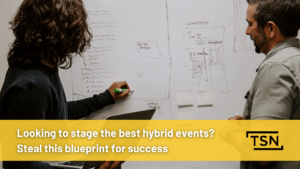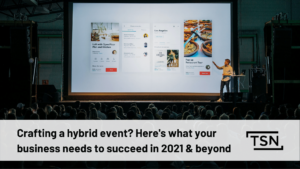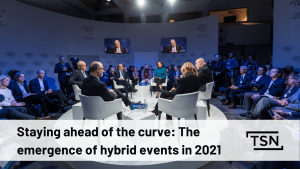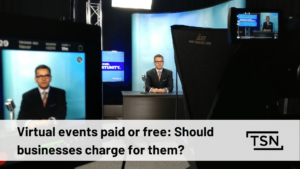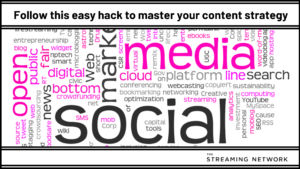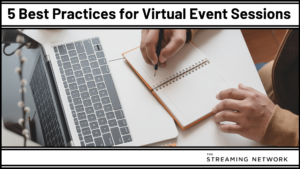Podcast: Play in new window | Download | Embed
Subscribe: Apple Podcasts | Google Podcasts | RSS
The Webinar: Lessons From The Frontline
Previously, on “The Webinar: Lessons From The Frontline”, we discussed the difference between a webinar, a webcast and a hybrid event.
Did you miss the introduction to hybrid events ? You can read our blog post about it here.
In Episode 19, Peter and I take it one step further. We will discuss exactly how to execute a hybrid event.
Some of the topics we tackle are as follows:
- What are the best practices when launching a hybrid event?
- How to ensure that your event runs smoothly, each and every time?
- What can you expect when you don’t use a checklist?
- How to prepare against the unavoidable last minute changes?
The Complete Video Transcript
Peter Vamos: Welcome to LFTF, Lessons from the Front Line. We’re doing something a little bit different today. We’re here in the usual studio, but as you see it’s slightly different. Matt is standing in front of a green screen, although you will not be seeing it as a green screen. You’ll be seeing all kinds of images behind him. Welcome, Matthew Ley, to Lessons from the Front Line.
Matthew Ley: Thanks. Thanks, Pete. And, you know, I never thought that I wanted to be a weatherman. And, in fact, I don’t because this is a little bit awkward, you know. We often talk about the fact that it’s not easy to stare down a camera like this. And it’s not. But, hey, it was set for another customer, we had to get some content done, so here we are doing this–yeah, another unique set that you are throwing at me for our podcast series.
Peter Vamos: This one will be fun, for sure.
Matthew Ley: Yeah.
Peter Vamos: So, our topic–we did a great podcast on hybrid events, and one of the things you promised was we’re going to get a little deeper into that–.
Matthew Ley: –Yeah–.
Peter Vamos: –How to actually–the nitty-gritty–how to execute against hybrid events. So, that’s what we’re diving into.
Matthew Ley: Yeah.
Peter Vamos: We’re going to start to talk about the various components there. So, let’s just start right from the beginning, as it were.
Matthew Ley: Sure.
Peter Vamos: How do you execute a hybrid event?
Matthew Ley: Well, that is a broad–a very broad topic–and I think that everyone has–will actually know what we’re talking about. This is a physical event that has a virtual element to it. Usually, it’s a webcast, and you’re expanding the reach because you don’t have enough bums in seats, or you want to reach a secondary audience. And if you’re not familiar with the concept, there’s a whole podcast that Pete and I did on that.
But, this year–it’s towards the end of the year–we’re doing our year in review today as well. And I’ve been analyzing some of the data on 2017. And one of the things that I realized was that our events practice has grown by more than it has in the last seven years, and that’s events like this, webcasts, on-site events, or hybrid events.
We do this early on in the year. We hired a lot of new people to be part of that team. But, I didn’t really realize the actual impact of it until recently, and so how to execute is a complicated question.
And what we’re going to do today is open up our best practices that we’ve had to document with the new staff and the new hires, so that we can handle this greater demand for the hybrid event and basically try and give you all of the best practices. So, Pete, to answer that big question, you got to start at the beginning, and you got to start with a good team.
Peter Vamos: Right, okay. Then, let’s go–in terms of describing–like what is a hybrid event? We talked about this in the last podcast.
Matthew Ley: Yeah.
Peter Vamos: But it is a physical event with a virtual audience.
Matthew Ley: Right.
Peter Vamos: Tell us–like let’s get right into that part.
Matthew Ley: It’s just that. It’s not a webinar, it’s not a virtual-only thing that happens from a studio. You’ve got a traditional bums-in-seats event. And due to many factors in today’s world, you need to take the message that’s happening in that room, and you need to expand it out to an audience who simply cannot be there in person.
They are either a secondary audience that’s just not that into you, they are people that are geographically dispersed and can’t make it into the room, whoever that might be. You’ve decided to do a webcast, and we call that a hybrid digital event with an in-person event.
Peter Vamos: It’s a big event, right?
Matthew Ley: Yeah.
Peter Vamos: No room for failure.
Matthew Ley: Right. And some would say perfection is unattainable, but you’re right, there’s no second chances when it comes to these events.
Peter Vamos: Where do you start? Once you’ve determined if a hybrid event is something you want to do, what are the next things you do?
Matthew Ley: Right, so I got a little ahead of myself when I started talking about the team. But, as we started to analyze the process that goes into making a successful hybrid event, we really realized that no matter how many checklists and best practice guides we could provide–many of which we have added to this, to the links on this page–it comes down to the team that’s involved because this team is a very interesting team.
It starts with somebody who is either the sponsor of the event at the company, the event planner, or the event-planning company. It involves a venue team generally because there’s a bums-in-seats event, so there’s a team running the venue. And it involves a production or an AV team and a webcast group or a virtual-event group, which is traditionally The Streaming Network.
Now, that team can be condensed, depending on the size of the event, but there’s always people that play each of these roles within it. And the key is having this team collaborate well together, many of whom have just met, as well as ensuring that people are doing the right thing on the team, so they’re in the right seat on that bus, to quote the book, Good to Great.
Peter Vamos: Right. So, what does that mean? Let’s start with–you know, with the event planner, the internal sponsor. Let’s–the first thing you mentioned there, like what does that entail?
Matthew Ley: Sure. Have you ever heard the story of the first Oceans 11 movie, Pete?
Peter Vamos: I know the movie and some stories–.
Matthew Ley: –Right–.
Peter Vamos: –But perhaps not this one.
Matthew Ley: Well, I’m not talking about the George Clooney movie, of course. I’m talking about the first time Oceans 11 was a major film.
Peter Vamos: Frank Sinatra.
Matthew Ley: Frank Sinatra.
Peter Vamos: Frank Sinatra.
Matthew Ley: So, Frank wanted to hold basically one of his shows in Vegas, and he wanted all of his friends to be there on stage–the Rat Pack, if you will. And he also wanted to do a movie with them. So, what he did was he bought the rights to the script, Oceans 11.
He, then, basically hired a director whose biggest credit to that point had been directing a Lassie TV show–sorry, not movie–and basically began as the guy who was the owner, producer, I guess–and the star of the movie–decided to call all the shots, not showing up on set until 11:00 or so every day because he was hung over from partying the night before after his show in Vegas, shooting for two to three hours, refusing to do second takes.
And so, anyone who worked on that production, who were all people that were professionals and worked on professional film sets before, talked about how horrific and hard it was, even though it was kind of fun to be there to make that movie.
And as ridiculous as that story sounds in the modern-day studio infrastructure–or, I guess, any infrastructure of how movies are made–that’s basically what we deal with with these hybrid events.
The person who is–who works for our customer, who is the event producer–many times has done very little of this, or it’s their first time actually ever producing one of these events. And worse than that, they are–the speakers and the business unit that they are supporting, often at C-level and important parts of the team–they are the ones calling the shots–who are the people that are supposed to be the ones that are, you know, on set doing what it is they do.
And around that team are a group of AV, venue people, and the webinar or the webcast team, who have produced, you know, hundreds of events this year probably–maybe thousands in their life–depending on the person that you get. And so, it’s–this event-planning team is an interesting group.
Now, it’s not always a member of the organization that’s doing that. Oftentimes, there is a company in place, an event-planning company. The same problems can arrive there, although we see it less, where the event-planning company has never been involved in shooting or being part of a hybrid event. And so, that team is probably the most important team and often the least experienced group that we pull together to actually put one of these on.
Peter Vamos: Right, okay. And what about the–let’s also talk about the webcasting because that’s a crucial part of the team.
Matthew Ley: Yeah. I mean, every part of this has to work together. And quite often, you know, you’ve got your event-planning company, you’ve got your venue that you’ve selected, you’ve got your AV team, production, whether it be in-house or whatever, and then you’ve got–last but not least, you’ve got us. So, we’re the last thought.
And as the last thought, we sometimes have the last voice and are coming late to the game. And so, you’re probably–well, yeah, probably. The data indicates that if you do this, you’re going to get two times the in-person audience virtually and four times when you take into consideration the on-demand. And so, even though we’re the last thought, what we put forward is actually very important.
Peter Vamos: Right. So, how do you keep it straight? You know, you’ve got all these different stresses on the situation–.
Matthew Ley: –Right–.
Peter Vamos: –All these different teams coming in. How do you sort of keep on top of all that?
Matthew Ley: Yeah, it’s a–I mean, it’s not easy. But, the easiest thing to do is to bring this diverse team together and ensure that there are–open dialog from everyone, and everyone’s voice and input is heard. And you do need to have one person who kind of manages the run of the day and the actions leading up to the event.
And for the execution part of this–we’re really going to talk about the execution of the technical part of the event–it really comes down to the 24 to 48 hours before–and inclusive of the live event where this cross-functional team really needs to come together.
And so, often it starts with some sort of a kickoff call where everyone gets on the same page, and we start reviewing things and requirements from each side. So, those requirements might be the time we get in, it might be the time we need for setup and testing, it might be little things like, you know, this piece of equipment needs to plug into this piece of equipment.
All that stuff is very important. And once that team has met and is in place, everyone should be walking away with their responsibilities with that one person holding the plan together and documenting what it is that everyone is going to do.
Peter Vamos: So, you need a document? You need something that actually–you’ve got a quarterback.
Matthew Ley: Yeah.
Peter Vamos: You’ve got a document. The quarterback is the master of the documents.
Matthew Ley: That’s right.
Peter Vamos: Okay.
Matthew Ley: Yeah. And so, a recommendation I would make is if you’ve never done this before, and you’re the person at the company who is tasked with planning this, we’ve offered a sample sort of sheet for how this can look on the day of and the day before around the live event, that we’ve–are going to offer to you for download.
But, the AV companies usually are very–or production companies–are usually very good at providing a run of the day. And if you just let–insert your needs, whether it be rehearsals or whatever it might be, and your webcast partner’s needs around testing and loaded, then that would be a great place to get that document going and moving for you, if this is a first time for you.
Peter Vamos: That’s great. In terms of precautions–.
Matthew Ley: –Yeah–.
Peter Vamos: –Like what are the precautions of not doing this? If you don’t do this, this can–what–like what is the sort of scenario that someone might be looking at?
Matthew Ley: There’s so many things. And we have an entire podcast on this, which is disasters and stories about this kind of thing happening. But–so, when you don’t get on the same page this way, some of the things that we’ve seen happen are that setup and testing times are condensed to a point where we’re going live with things, and we’re not sure–we haven’t looked at them yet.
If you look at the venue, for example, as a start point–is that if we’re not in line with what the venue–with the venue’s–if our requirements are not communicated to the venue–or AV’s are not–there could be things–there could be watch-outs that we didn’t know that drastically delay and inhibit our capacity to get this event set up–or even to execute it. And so, as you go down, this happens across all of the various parts of this cross-functional team.
So, I would suggest that if you’re in the middle of a planning session, and any member of this team says things to you like, “Oh, don’t worry, our Internet is great, we do this all the time,” or, “It’s not my first rodeo, we know what we’re doing. Just show up, and we’ll plug in your computer, and it will work,” anything like that, that’s fine. There’s a lot of professionals, many of which have done this a thousand times before, but that cavalier attitude is how these events fail.
Peter Vamos: Right, excellent. I think I just saw Stanley walk behind you there. That was quite something. So, what are some of the things that your team does to help this, like when you bring them in? Obviously, these are the pros from (unintelligible) that come in.
Matthew Ley: Yeah.
Peter Vamos: Like what are they doing?
Matthew Ley: Yeah. So, you know, we’re used to coming in, like I said, kind of last, if you will. So, you know, one of the things we do right away is we get an understanding of what that venue is, and we test the Internet.
So, we’ll go in, and we’ll either–we have a way of remote testing, or we will actually send a human being on our team to the venue to do a survey. And we will plug in, and we will do both Internet and port tests.
This is–as the Internet is becoming much more available, this is not as big of an issue as it was maybe five or six years ago. But, we’re used to doing it because we have been burned, and so we will always do that. We’ll always do that test and ask some questions about the Internet–primarily, is it dedicated, are there redundancies in place, and, you know, what can we expect for our own Internet?
Then, when we get there, the first thing we do is we check the Internet again, and then we stream for 30 minutes, making sure it works. And then, we test it again because, as you well know at home, when you’ve had issues in outages and problems–is that Internet can have issues day-to-day, or whatever it might be, so it’s very important that we test check–always continue to test on this.
And that’s because for us the virtual is the most important part. That’s what we like to focus on. That’s what we do–not like to focus on–that’s our job. That’s what we have to do. And so, although the show must go on in a hybrid, it has to occur–our show cannot happen without the Internet. There is no other way that we are going to get the signal out and make it work, and so we need to make sure that that is rock solid.
Other things that our team will do is they will ensure that we pack extra in our kit. No matter how much we talk about–to the AV team or to the venue team–there’s always things that we don’t know, and there’s always things that can come up. And the best thing in–when you’ve got that collaborative working group–is if you’ve got a little bit extra that you can hand over or help out if someone gets in trouble because time lines are very, very, very condensed on site.
Peter Vamos: I find that interesting because I think there’s a story–.
Matthew Ley: –Yeah–..
Peter Vamos: –The CBC studio 40 story–.
Matthew Ley: –Oh, yeah–.
Peter Vamos: –That relates to this.
Matthew Ley: Yeah.
Peter Vamos: Can you tell us that story?
Matthew Ley: Beyond–I think that the reason this happened was really the guy was mad at me for something completely unrelated, which was I got thanked by the star of a show for producing such a good show, just because I was wearing a suit coat and a CBC t-shirt that I had bought because it was my first time working at the CBC.
But, this was years ago. This was a different time. But, still it was something where we had provided a list of what we needed, down to–we had to give them how one cable connected to another cable, whether it was a male or female, as they call it in AV.
And we got there. And when we went to plug in–which at the time was a very extensive setup. We were doing live English, French, and what’s called floor feeds. We couldn’t connect to one another. We were both–we both had males, and they wouldn’t connect.
And so, we had literally zero mechanism from the time we were going in until the show in the morning to get this. It wasn’t that there wasn’t a Best Buy available, and there may not have been enough on there. And when we went to the gentleman who was running the show, he basically said to us that, “You know, we set up what you asked for and nothing else.”
And so, instead of being able to basically just work together, we had to go back to our e-mail, prove to this guy that we actually had asked for the right thing, for him to go into a box and give us the six turnarounds that we needed to make this show happen.
This was a time where we had zero contact with this production team because they were the in-house TV guys. And they just–they do this all the time, so we didn’t need to talk. But, if could have been cached off, even though he did have it right there. He was acting at one point like he didn’t even have these at all.
Peter Vamos: Right, amazing. So, even if you do all this, things can change on the ground.
Matthew Ley: Yeah.
Peter Vamos: It’s hard to anticipate.
Matthew Ley: It is.
Peter Vamos: Yeah.
Matthew Ley: And, I mean, the–you always go in expecting that your run sheet is going to be followed and that things are going to happen. We’ve got wild cards here, right? No matter what we do, the wild card is always–well, not always–but, a lot of times the wild card is the customer.
We are not dealing with professional actors and news people who are–this is the most important thing they’re doing. They are a CEO who has just completed a major merger or acquisition who is working on the language that he wants to use, or whatever it might be. And so, business needs to go on. And so, there’s a lot of things that can be thrown at us that can adjust and affect the schedule.
And so, what’s–the watch-out and the important thing to know here is you want to build as much buffer into your schedule as possible because you know these things are going to happen, rather than calling us and asking us, “What is the last possible hour that we can give you PowerPoint slides,” or, “What’s the last possible time that we can do X, Y, or Z?”
And that’s a common question that we always get. So, we want to build as much time into this as possible such that we can deal with these changes–changes in the last 24 hours before an event to time to scope–or to the agenda. These three things can negatively adverse your event.
First off, they almost always cost you money. You have to remember, at events like this there’s a lot of expensive equipment, a lot of hands required to set it up and execute it. And that stuff has to come on trucks, and there’s labor hours associated with it.
And when you change time, you affect everything else that’s going on, plus sometimes there are up to three companies–or four companies–that are involved. You have the venue guys, you’ve got the outsourced AV, you’ve got us, you’ve got other people. And so, you change something–you’ve got to make sure that all members of the team are able to work around that change.
But, the last thing–and the most important thing–is that you add risk. You add risk when you’re changing things last minute.
When it’s 6 o’clock at night and you’re deciding, “You know what, we want to have an extra camera on this,” or, “We want to have an extra this,” or, “We want to change the way that we’re doing that,” and the show is happening at 8 a.m. the next morning, and you have access to the room for one more hour, that can cause complexity because now, no matter what you’ve done from a testing and a setup protocol standpoint, you’ve got a very slim amount of hours to make those changes, which, again, just leaves you for a possibility of failure and error.
Peter Vamos: Right, so a lot of work in the lead-up to it.
Matthew Ley: Yeah.
Peter Vamos: A lot of sweat put in–a lot of sweat equity. The–but, the day of the event, showtime–.
Matthew Ley: –Yeah–.
Peter Vamos: –I mean, this is–all this effort, and then you’re on the ground. Let’s talk a little bit about that. What are some of the things you’ve got to be cognizant of, going in?
Matthew Ley: Right–is that before the event, you’ve got e-mail, you’ve got everyone’s cell phone, you can pick up the phone, and you can call them. It’s not easy, but there’s room to have fractured lines of communication to get to the outcome.
But, on site that’s just not the case. If audio isn’t working, or if something else isn’t happening, or whatever it might be, you’ve got to fix it immediately. So, going into the day, if you don’t have it, you need to understand, you know, on the AV team who should the webcast person speak to? Who is the guy?
So, our team goes on site, and they’re like, “If I’ve got a problem, who do I talk to about X, Y, or Z?” If you’re the customer, and you’re the producer, who are you going to about certain things? Are you dealing with the person on the ground?
When we have one person on the ground, we–and we know that there’s a possibility for that–we will drive some of the on-site people–and especially the virtual folks–to contact the office, where we’ve got our CSMs and our customer service to respond because the person on site’s focus is executing on this event and making sure that it’s a success.
So, you want to make sure you know who to talk to about what and where certain inquiries go, so that they can be resolved the quickest–webcast inquiries go to Support, broadcast inquiries go here, whatever it might be. And those lines of communication need to be open, and they need to be there.
And basically, when that is in place, and you know what’s happening, then your life gets a lot less frantic on site, but, most importantly, so does everyone else’s. When you’re frantic or when you’re asking AV to do something in the middle of the show, or you’re changing something over here, there’s always something else that that person was supposed to be doing that’s not getting done.
And so, these lines of communication ensure that changes or things that occur during the event–questions, comments, or concerns–don’t affect the event. They only affect that one person who is a cog in this greater wheel.
Peter Vamos: That’s great. So, it’s an event, but it’s a virtual event.
Matthew Ley: That’s right.
Peter Vamos: So, the event is done, but that doesn’t mean the event is done, right? You’ve got this entire portion that has been captured. What do you do with that? What–you leave the event–what are the next steps, what are the next phases?
Matthew Ley: Yeah. And that–you know what? This is at the end because logically it occurred at the end of this. But basically, this should be handled in the planning stages. So often, when I used to be on site, someone would walk up to me and say, “When will the archive be ready,” or, “We’re going to have to do some chaptering.”
And then, we would go the next day, and we’d get an e-mail, and the chapters were the speakers’ names or something like that, or just what they–when they spoke. It was simple. And so, this can easily be handled in the planning.
And you should plan that because you have four times your audience on-demand. You get a bunch of people on-demand for free events, like a one-hour whatever–announcement event, webinar-style marketing event. You get most of those people within the first 48 hours of that first week on-demand. So, you want to turn this thing around quickly, and you should plan all of that.
Other things that you should do as safety precautions–if you haven’t decided how you’re going to use all the footage–is you should go out, and you should make sure you’ve got a plan to get that footage and when you’re going to get it.
If possible, sometimes you can leave the venue with footage. Oftentimes, you need to get a drive or something later, but keep the footage. You never know how you might want to use it in some other post-production sort of experience.
Peter Vamos: Fantastic. So, let’s move on. We like to have a moment of zen. And sometimes we don’t have time for it, but we do have time here.
Matthew Ley: All right.
Peter Vamos: So, let’s do our moment of zen. It’s easier–give us what you think–the moment of zen for this particular subject.
Matthew Ley: My moment of zen on this.
Peter Vamos: Your moment of zen.
Matthew Ley: Well, you know what? My moment of zen comes from my personal experience. And that is that, again, we’re last in line on these events when we should be sort of, I think, near the front of the line as it relates to it.
The way you frame a shot for a webcast is different than the way you frame a shot for the collection of footage at a conference. The requirements for setup, testing, protocols, and the like are different for a webcast company than they are for an AV company.
Usually theirs are longer. But, in some cases it’s not the case. And so, if you bring us forward earlier, we can not only help ensure the success, but what we can also do is help ensure that your virtual audience enjoys their experience.
It’s very common when I watch an event–I can almost recognize who has produced it, whether it was a company like ours or an AV company or the like, because you can very clearly see the difference between when you’re watching a webcast, and you feel like you’re just watching in–that it’s something that’s happening in person, and you’re not–you know, you’re a secondary audience–to feeling like you’re actually a part of the experience. And that is something that your webinar or webcast virtual event provider should bring to the table.
Peter Vamos: Fantastic. That’s great. I’m going to close things off.
Matthew Ley: Sure.
Peter Vamos: And I want to say thank you very much–really insightful. I think we’ve got a great package around hybrid events now, and that’s–anybody who is interested in producing these sorts of things, they have got some great resources.
Once again, my name is Peter Vamos–Matthew Ley from The Streaming Network–.
Matthew Ley: –The weatherman.
Peter Vamos: The weatherman–our weatherman. And we will see you next time with our lessons from the front line.
Matthew Ley: Thanks.
Peter Vamos: Thanks.

